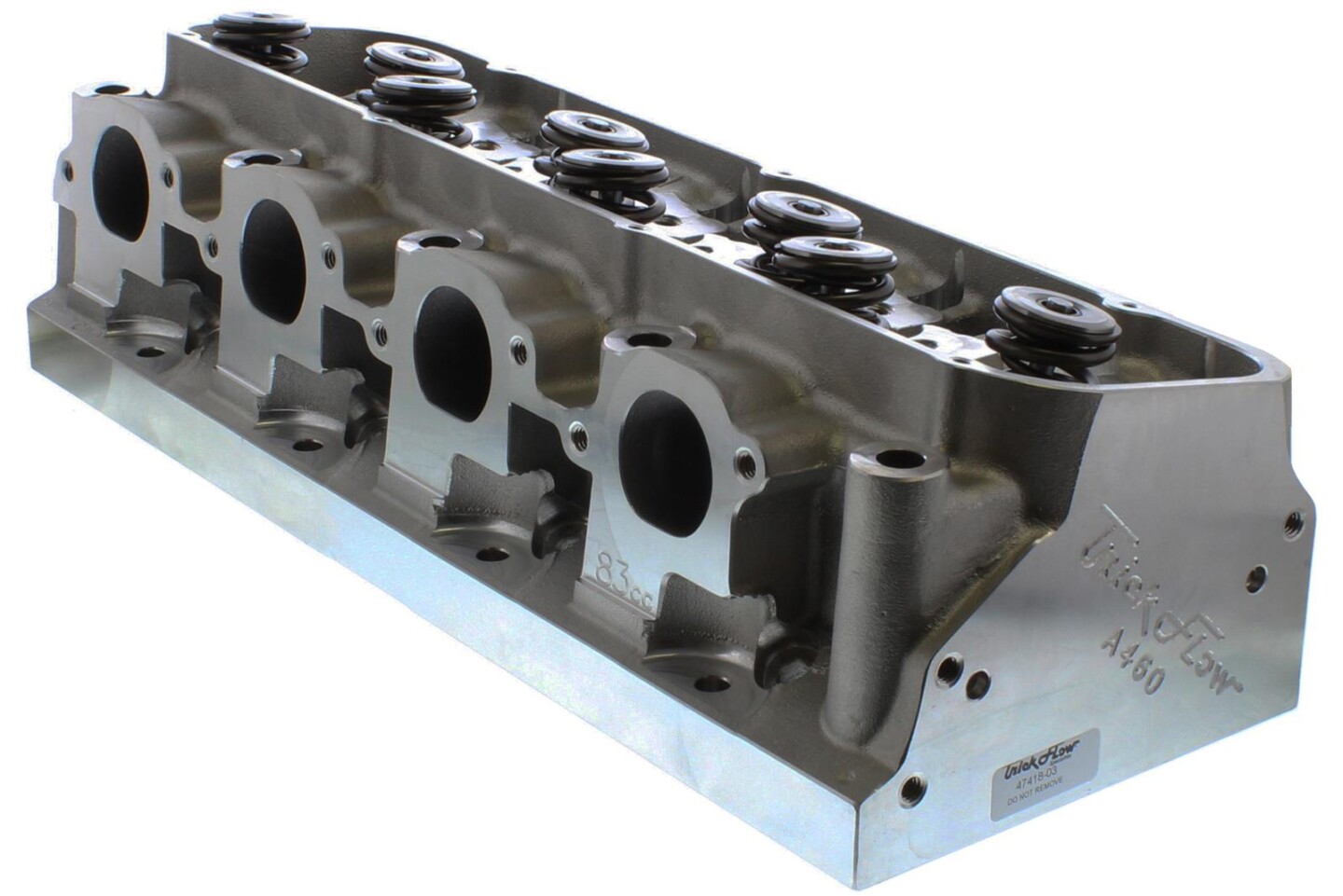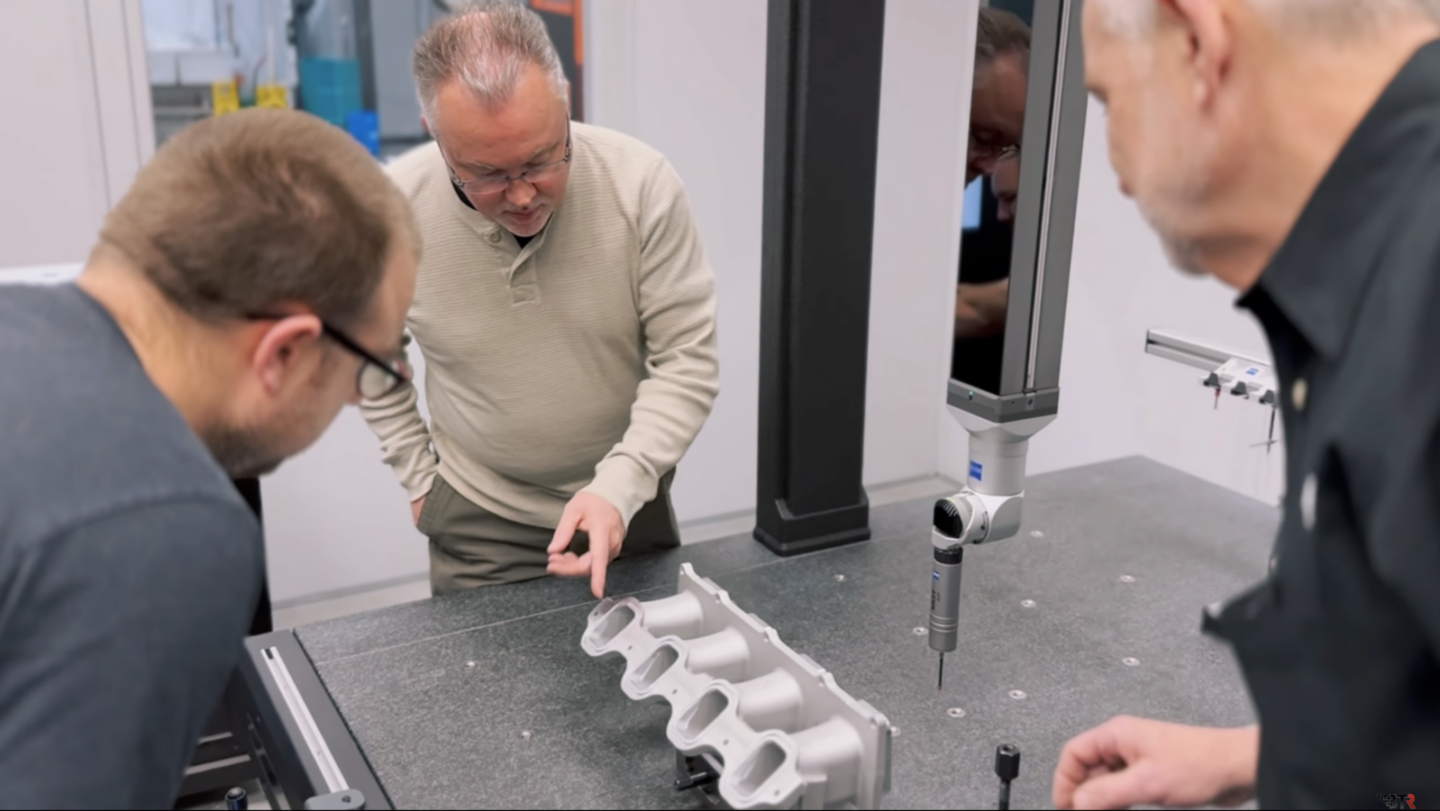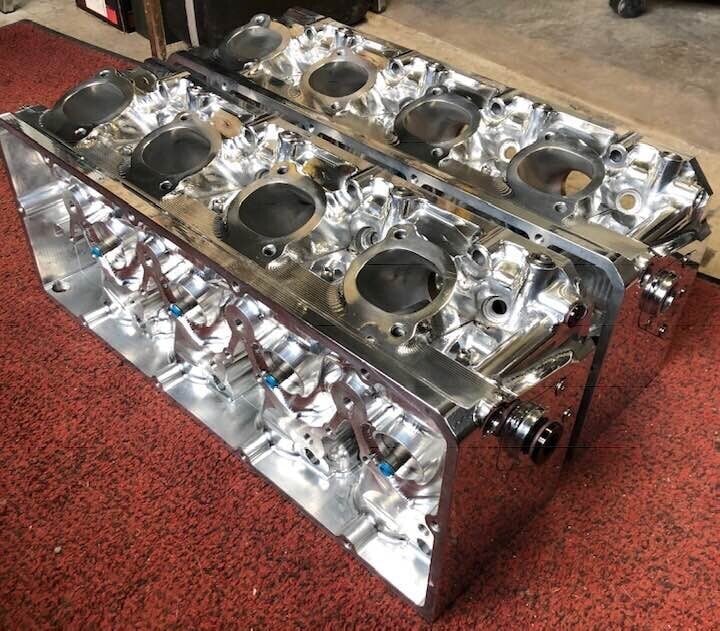https://www.enginela...ard-rick-smith/

Rick (left) and Mike Smith carving heads in the garage in this Instamatic capture.
Known for so many innovations in ported cylinder head development and valvetrain components, in the beginning, Rick Smith almost used his hands a different way: as a surgeon! He was in a pre-med bachelor’s program at Wayne College at the University of Akron. However, to the benefit of his 40-year-long customer fan base, he was also a skilled machinist with an engineering mind.
“Well, it is an evolution,” says Smith. “I was actually a surgical orderly while I was going to college. I was in surgery every day with doctors scrubbing up for preps and surgeries. I witnessed all kinds of things: amputations, childbirth, C-sections, open hearts, the whole thing. So I went from that environment to dirt under your fingernails all night. I really needed the money to support my Mustang habit. I wanted to buy this B&M torque converter…”
The Smith brothers were around parts-making from a very formative age. “I went to work in the tool and die shop where my brother worked, sweeping the floor. Because of all this exposure at 10 and 11 years old of looking at graphs, and graph paper drawings, I had a natural ability to read a drawing. I couldn’t believe blueprint reading was actually a class. It seemed to me that it was intuitive. Everybody can make sense of this. It’s obvious! You know, there’s an extension line. There’s a number. That’s the distance from this to this.”

The Ford big-block A460 cylinder head modified by Rick put Trick Flow Specialties on the leading edge of the industry.
Working in the tool and die shops piqued Smith’s interest in casting and pattern-making. So began Rick and Trick Flow’s venture into the parts-making business in the early 1980s. It consisted of Smith machine-tooling in a two-car garage with his brother Jim. “I look back on making hundreds of heads out of that garage on a Bridgeport without a drawing, let alone a 3D model. It just blows my mind, that people bought that stuff. I know how much they must have deviated from one set to the next. We did some crude fixtures.”
However, this effort led to one of the most innovative high-performance heads in history. Known by its Ford SVO part number, A460, the canted-valve head gave big-blocks great horsepower gains and rock-solid efficiency. Ford signed an agreement with the Smiths for the part in 1986.
The canted-valve cylinder head design features intake and exhaust valves that oppose, each pointing toward the cylinder centerline. It’s an advantage that allows for larger valves and lessens the risk of shrouding. The result is maximum airflow.
“It’s fun making parts. What’s really fun is making money, making parts. This is the part that eluded me when I owned TrickFlow. Because I was so enamored with the craft of making it, that we really did not focus on making money,” says Smith. Summit Racing, however, saw a money-making opportunity.
Smith sold Trick Flow to Summit Racing in 1993. He continued on, as part of the agreement, and designed the “Twisted Wedge” cylinder head for small-block Chevy and Ford cylinder heads. This gave Summit Racing a preeminent manufacturing advantage. Twisted Wedge heads feature kidney-shaped combustion chambers with altered valve angles, which allow for improved airflow and more efficient combustion.

Stormin’ Norman Gray and his Mustang that used Trick Flow heads dominated Smith’s inaugural Five-Liter Shootout. Image courtesy of Corral forum member fiveoh.
In concert with Super Fords magazine, in the early ‘90s, Smith created the Five-Liter Shootout to showcase the Twisted Wedge design. “In the 1995 Era, when I sold Trick Flow to Summit Racing, I predicated the idea of the Twisted Wedge done for “Stormin’ Norman” Gray when he raced the Mustang that Roush had built.” The Mustang folk-hero drag racer spanked the field in the Fox-bodied racer during the inaugural Shootout event at National Trail Raceway.
Beyond his ability to hand-tool, Smith has kept up with the latest technologies over the years and has numerous accomplishments in the automotive OE and aftermarket spaces including 11 internationally recognized patents. The late 1980s and early 1990s saw the rise of computer-controlled machine tools and Smith has been a constant student and quick study of mechanical engineering technology. Understanding and physically creating the analog concepts from his history, then using and programming the latest machine tool tech has made him a sought-after expert.
BTR Grows To Increase CapacitySince joining BTR in 2018, Smith has been responsible for continued innovative design and the inspiration to complete more internal manufacturing, including all the Trinity and Equalizer intake manifold castings. “We have teamwork that gets involved with the development of these, but ultimately it comes down to designing the tool and getting it made,” Smith says.
“I am a manufacturing guy. I love to make parts. I love to make chips. I’m a programmer. I’m a designer. But most of all, I love to make (parts),” Smith says. During Smith’s BTR onboarding, Tooley had bad news for the legendary machinist. Tooley told Smith, “This might be a little disappointing, but we’re not going to actually cut anything here. We’re going to sub it all out, but we’re going to do all the design work. You’re going to do the custom stuff for the big racing team clients.”
“But it went 180 when we realized the flexibility of having our capability in-house and making the stuff,” Smith recalls. “We started buying equipment and put up the new building last year. BTR dropped millions of dollars on a brand new Mazak CNC machining center, a Landis Cam Grinder, a Takumi 3-axis CNC machining center, a 5-axis Haas CNC machining center, a Hurco, and a CMM (Coordinate Measuring Machine). We now cut tools in-house.”

Brian Tooley (center), BTR Machine Shop Director Justin Small (left), and Brian Wolfe (right) inspect a Godzilla intake runner casting on the CMM.
As Smith works his days at BTR, he really is amazed at how far technology has come. He has been able to surf the shifting paradigms in his career, yet he is frequently reminded of a long-ago time. “I mean, it was nasty. Dirty. We were in our t-shirts, in the middle of the night, cutting cylinder heads on a Bridgeport and a CNC Bridgeport, and a little Natco-10 spindle drill press and it was strictly out of the passion for the craft” says Smith.
But a machine shop is an entirely different animal in 2023. However, getting it right still takes time and patience. “Now we use screening, 3D, and sand-printing technology to make prototype castings to take to the foundry. Then we pull the castings and bring it back and machine it. We then run the part on sophisticated testing equipment. It doesn’t always go like we had planned.”
The state-of-the-art testing equipment is fun to watch and can be seen on BTR’s YouTube channel. There is also a video tour of their latest facilities. “From there, we develop a production method, make the production tool, and make production castings. We then prove those samples, bring them back, and machine them.” In addition, there is a distinct possibility of BTR investing in its own foundry at some point.
Porting A Chevy Just Like A FordWith all the early work and successes it would seem strange for a man who seemingly bleeds Ford Blue to develop GM LS parts. “I’m known primarily for the high-port stuff, the Twisted Wedge stuff, and the A460. But now I’m working on LS stuff. It’s basically a Ford, anyway,” laughs Smith.
“In fact, the first time I ever saw an LS head I was at Al-Fe Heat Treating in Wadsworth, Ohio. I saw a basket of heads. But what I saw was obviously a 10-head-bolt, small-block-looking head and it really had a very nice-looking exhaust port, much less constrained to my Ford bolt pattern exhaust. I thought, ‘What the hell is this?’ Then I saw the intake port, which is the cathedral port. Ironically, I was working on a cathedral port intake at the same time. But I saw this cathedral port intake and I thought, ‘Whew, that was a close one!’ That was my first exposure to the high-port head.”

Rick created this set of one-off billet Ford big-block heads for Darrin Magdowski at ET Heads. They featured a reverse image design with five-inch bore spacing. Built for a class-specific 765 cubic-inch engine that was naturally aspirated with a single four-barrel carburetor, the combination made 1700 horsepower.
Through a foundry representative named Ross Thacker, Smith was introduced to “The Father of the LS,” Ron Sperry. Shortly thereafter, Chevrolet came out with the LS. “And I look at that and I see a Ford. A much better Ford than Ford made, actually. Interesting. So it was an easy transition.”
The Things We Do For Our CarsDuring Smith’s pre-med days, he was still pouring earnings into his Mustang. “I wanted a Hole Shot B&M torque converter. I already had the Crane Fireball Camshaft. But I needed 50 more dollars and I just got a raise at the hospital,” Smith remembers. “I’m like, ‘Man, I’m 50 bucks short!’ I wanted to go buy this converter at Summit Racing, just up in Akron about half an hour from us.”
It was on this day, that Richard Smith would prove his undying commitment to the car passion.“So there was a men’s bikini contest and I used to lift weights. The local hangout was a disco called the Red Baron Saloon. My younger brother Doug and I went out there and I bought a can of Sudden Tan and a Speedo swimsuit. I went out and competed and got the extra 50 bucks,” laughs Smith. Rick was kind enough to send historical photos. We just wish Rick had sent us a picture of that!
Life is all about choices, and it’s incredible to think that if Rick had followed his mother’s urging into medicine the automotive industry may look much different than it does today in terms of cylinder head development, technology, and performance. Looking back on an incredible career that is still reaching new heights, Rick speaks with pride for the next generation of engineers who might follow in his footsteps. “Ironically, two of my four sons became doctors. My second son is a professor of mechanical engineering at the University of Illinois, and my third son is a calibration technician. He’s the un-degreed engineer. He does engine calibration for an OEM stationary power engine manufacturer,” Smith says.
We thoroughly enjoyed our conversation with Rick, and we look forward to seeing what new developments and parts he dreams up with the team at Brian Tooley Racing.











